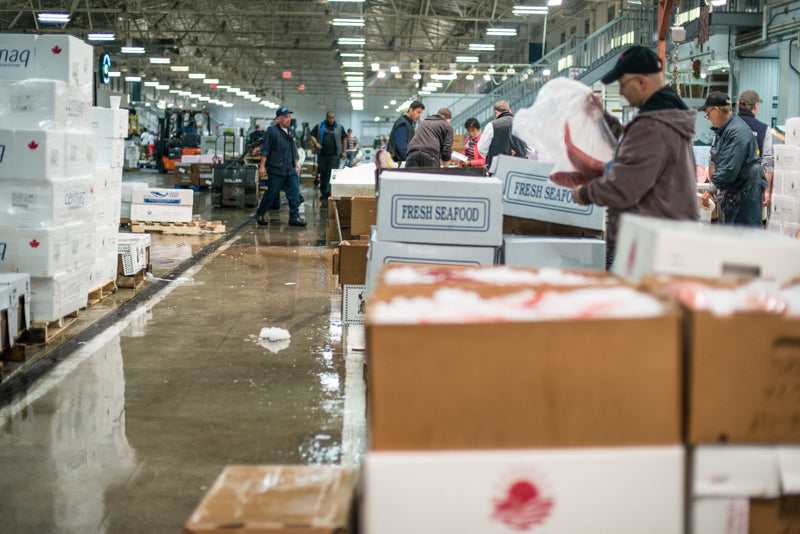How The Fulton Fish Market Works

The Fulton Fish Market first began operating along the East River in Manhattan, NYC in 1822. Long before the Brooklyn Bridge and the Statue of Liberty were constructed and became famous New York City icons, the fish market was bustling and thriving in lower Manhattan. It is the largest fish market in the US and the second largest fish market in the world. From 1822 to 2005 it operated continuously in its original location and in pretty much the same fashion. In 2005 we decided to upgrade and modernize our operations by moving to Hunts Point in the Bronx, right next to the meat and produce markets, becoming part of the largest food distribution center in the world! The benefits of the move instantly became obvious. Instead of operating out of ramshackle old buildings, exposed to the elements, on cobblestone streets, we were now inside a gleaming new, 400,000 square foot climate controlled modern building. Sheltered from the rain, the snow, the cold, and the heat, it is immeasurably better for the fish, the customers, and the hundreds of people who work there. While it may seem like complete chaos to the casual eye, it is extremely organized and efficient. It’s like being inside a giant, finely tuned Swiss watch, with a thousand moving parts, each part moving in consistent precision. To move hundreds of millions of pounds of fish every year takes a lot of logistical expertise, and after 200 years of practice I think we’re getting the hang of it!
The fish market itself is a co-op made up of approximately 30 independent fish companies. Each company has their own area of expertise; some stands are quite specialized in what they sell, some sell a little bit of everything. On any given night you can find fish from every continent all around the world. Fish begin arriving at the market in the evening and our facility can unload 20 tractor trailers at a time. The team of unloaders know by the manifests which stands are getting
what fish and, using forklifts, speedily deliver the goods. Each independent company has their own team of workers who break down the pallets and set up the stand according to their fashion, and get ready to sell.
The salesmen now start looking for customers. When prospective buyers come on the stand, the haggling begins, a price is agreed on, and the fish is marked up for the customer. There are parking zones all around the entire perimeter of the building, and each stand's delivery men (called journeymen), know exactly where each truck is parked, according to the customer’s number, name, or code. The journeymen on their forklifts go out to the appropriate loading zone where loaders help direct them to the customer’s truck, and the fish is stacked and loaded. The journeymen write down exactly what was delivered and to what customer; the loader also notes how many pieces, what kind of fish, from what company, etc. When the customer is done buying for the day, and is assured by the loaders that everything is on the truck, they go on their merry way back to their store or restaurant or what-have-you. These sales and deliveries go on all night long and finally, when all the customers have gone, it’s time to take inventory and clean up.
For years the best chefs in New York City have seen the value in coming down to the market themselves, actually seeing the fish and meeting the vendors. By doing so they can establish what they specifically want and get a first hand understanding of all the choices the market offers. It seems at one time or another all of the big name celebrity chefs have come seeking to ingratiate themselves: Eric Ripert of Le Bernardin, Dave Pasternack of Esca, David Bouley of Bouley, David Chang of Momofuko, and Andrew Zimmern of Bizarre Foods have all made and still make appearances. In the past, Paul Prudhomme of K-Paul’s, the man who made Blackened Redfish the most popular seafood dish in the country in the 1980s, used to come to the market whenever he was in New York. The great Anthony Bourdain was also a frequent visitor over the years. Many restaurant owners take the easy way and call a broker or distributor for their seafood. They never see the fish, never see all the choices they have, don’t know the vendors, don’t know the market. But the great ones, the chefs who have distinguished themselves among their peers, all appreciate how worthwhile it is to take time from their busy schedules and come to the market because they know how important these connections are to their restaurants. Building trust and working with the vendors this way, these chefs are assured of great fish, and have the advantage of personal contacts and all the information these contacts can share.
Historically, The Fulton Fish Market has not only been important to chefs and restaurateurs, but also to fishermen. The immense buying power of the market can give developing fisheries a tremendous push, and this has been demonstrated several times over the years. For example, in the mid to late ’70s, while the US was rebuilding its fish stocks, certain New York state and federal economic and development programs began to encourage the public to try calamari. It started to get some good press, and the vendors in the market told the boats in Long Island, Gloucester, and other ports to send all they could and we would push it. Every restaurant and chef that came to The Fulton Fish Market was encouraged to try some and sales continued to rise through the 1980s. By the 1990s, it was ubiquitous, fried calamari was one of the most popular appetizers in the country. Chilean sea bass is another example. It first came around in the early ‘80s, and unlike calamari, which was at least familiar to many immigrants, no one had ever seen Chilean sea bass before. We were told if we could sell it we could make money, there was plenty of it and it was relatively cheap. I remember filleting some of the larger ones and giving away 2 or 3 pounds to my better restaurant customers, telling them, “Just try it.” It gained a lot of momentum and by 1990, The Four Seasons in New York City was serving it. Its popularity seemed to increase exponentially every year and by the early 2000’s it was so popular it was becoming endangered. The Fulton Fish Market has always spearheaded sustainability and healthy oceans, and from then on would only buy Chilean sea bass from sources that complied with newly drafted international fishing regulations, specifically concerning Chilean sea bass. By 2017, more than half of the world’s catch was certified healthy and sustainable by the Marine
Stewardship Council (MSC).
FultonFishMarket.com benefits greatly by being located in the market, and every night we are the first ones on the floor, looking at all the new product. Our decades old relationships with these vendors assure you the best fish every night, and no one has access to better fish than we do. Our customers can now enjoy at home the same superior quality and the same extensive selection of seafood that was once reserved for only the finest chefs in the country. We are proud to be the industry leader in bringing the best fish from all over the world directly to you.
